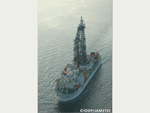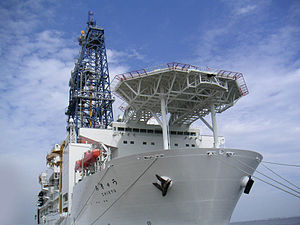Toutes les grandes villes du monde seraient sous l'eau pratiquement !!!
Il n'y a pas de pic pétrole ou de carburants !!!
http://en.wikipedia.org/wiki/Chiky%C5%AB
http://www.ship-technology.com/projects/chikyu/
http://ocean.si.edu/ocean-videos/ocean- ... sel-chikyu
http://mdn.mainichi.jp/mdnnews/national ... 6000c.html
http://www3.nhk.or.jp/daily/english/19_05.html
The vessel, called "Chikyu" which means Earth, will dig about 260 meters below the seabed and set up four wells.
One of the four wells will be used for methane hydrate production tests and the remaining three will be used to monitor possible changes in the environment, such as temperatures.
In March 2011, the Chikyu drill ship was damaged by the earthquake and tsunami in Japan. It was repaired at Shingū, Wakayama dock and returned for service in June 2011.
Chikyū (ちきゅう?) is a Japanese scientific drilling ship built for the Integrated Ocean Drilling Program (IODP). The vessel is designed to ultimately drill seven kilometres beneath the seabed, where the Earth's crust is much thinner, and into the Earth's mantle, deeper than any other hole drilled in the ocean thus far.
Japan, US to test methane hydrate reserves
Japan's semi-governmental energy body and a major US energy company have sealed a deal to test for methane hydrate reserves in the northern part of the US state of Alaska.
Methane hydrate is a type of natural gas formed from methane and water.
Japan Oil, Gas and Metals National Corporation, or JOGMEC, made an agreement with the US energy firm, ConocoPhillips, to carry out testing from January next year.
The 2 entities will back a project to dig a well up to 1,000 meters that will gauge the amount of gas contained in the area.
Methane hydrate reserves have also been identified in sea beds off Japan's coast. Some experts say the amount is potentially so great it could meet Japan's gas requirements for one-hundred years.
Japan is seeking ways to efficiently extract these natural gas molecules. It's hoped the joint experiments with the US firm will pave the way.
Wednesday, October 19, 2011 06:14 +0900 (JST)





